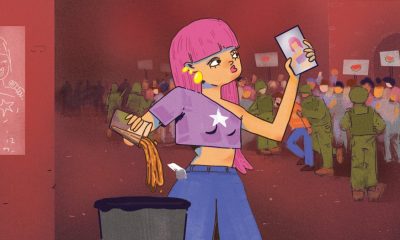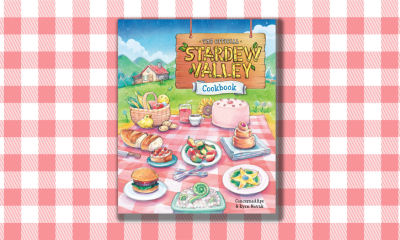Entertainment
‘A Haunted Girl’ uses horror to discuss mental illness

In A Haunted Girl, a new four-issue miniseries co-authored by comic book writer Ethan Sacks, the chosen one destined to save the world is a teenage girl who also happens to be depressed.
The story is personal to Sacks, who has penned Star Wars and Marvel comics. The concept for A Haunted Girl came to Sacks in 2019, as he waited in the cafeteria of the hospital where his daughter was being treated in the pediatric psychiatric ward.
Naomi Sacks, now 19 and a co-author of A Haunted Girl, had experienced severe depression, anxiety, and suicidal ideation. In that moment in the cafeteria, Ethan drew inspiration from her mental health struggles and imagined a character who ultimately triumphed in more ways than one.
For Naomi, co-authoring the miniseries gave her the opportunity to see her past through a different perspective.
“I hope that people who are going through dark times can relate to the character and understand that even if everything doesn’t become magically perfect and OK, you can still get through it,” Naomi told Mashable.
‘Everything Everywhere All At Once’ has the greatest take on mental health you never expected
That character is Cleo, an adopted 16-year-old Japanese American. Like Naomi, Cleo’s anxiety and depression drive her to suicidal thinking, for which she is hospitalized.
Paranormal happenings in the hospital and after she’s released make Cleo question her grip on reality, but scenes that don’t involve Cleo make clear that she’s not hallucinating or experiencing psychosis.
Instead, Cleo turns out to be the last living member of an ancient lineage with the power to fight this paranormal threat, but she just doesn’t know it yet. In other words, cue a looming supernatural apocalypse.
Ethan and Naomi decided to make A Haunted Girl a supernatural horror story because the genre created an important distance between the reality of what Naomi experienced while also mirroring the emotions they both felt.
“Frankly…as family it feels in the moment sometimes like you’re in a horror movie, it’s terrifying,” Ethan said.
But the greatest horror films are also cathartic, he added.
As the story progresses, Cleo becomes stronger and more capable. While Ethan is careful not to spoil the plot, he emphasizes that the conclusion is definitively positive.
To prepare for writing the story, Ethan and Naomi watched a series of horror films. The film that stuck with Ethan was The Exorcist, not for its demon possession but for its portrayal of parental suffering and feeling unable to help. He also borrowed from the “chosen one” theme of Harry Potter, Buffy the Vampire Slayer, and Star Wars to inspire Cleo’s journey.
Fresh to comics writing, Naomi drew particularly on her love for cartoonist Raina Telgemeier’s book Guts, which chronicles a teen girl’s experience with anxiety. Naomi appreciated how Telgemeier visualizes “getting in one’s head.”
For more Social Good stories in your inbox, sign up for Mashable’s Top Stories newsletter today.
Writing the series while Naomi was away at college meant collaborating on drafts via Zoom and Google Docs.
During that process, it was important to Naomi that Cleo have a personality independent of her depression. Naomi was largely responsible for writing scenes that take place at school, the hospital, and therapy sessions. She also included some of the same coping skills she learned in her recovery journey, like a grounding exercise for emotion regulation and going outside for physical activity and sunshine when feeling anxious.
Ethan mostly handled the scenes with demons and supernatural elements. Illustrator Marco Lorenzana incorporated Japanese horror aesthetics for the comic’s art.
Setting aside their artistic influences, both father and daughter felt it was important that A Haunted Girl avoid perpetuating myths or stigma related to mental illness.
Ethan reached out to the American Foundation for Suicide Prevention (AFSP) and asked for sensitivity readings of their drafts, in order to exclude material that could be triggering or create suicide contagion, which can particularly affect young people.
Brett Wean, AFSP’s director of writing and entertainment outreach, provided feedback about the portrayal of elements like the depiction of mental health professionals and psychiatric facilities.
Wean told Mashable that he aims to point out major missteps to avoid as well as offer simple, creative ideas for how to safely tell a story in the artist’s preferred voice and tone. “Subtle changes can make a big difference,” he wrote in an email.
Wean said that, as a horror fan, he appreciates how the genre appeals to viewers who enjoy watching things work on a metaphorical level. In many horror stories, that means fear is transformed into a literal monster.
“It’s so hard to see hope when you’re in the midst of crisis, whether it’s yourself or you’re worried about someone close to you,” Wean said. “This is Ethan and Naomi on the other side of it, showing that things get better, and that monsters can be defeated.”
Ethan and Naomi followed many of the suggestions they received from Wean and other sensitivity readers, including removing the often pejoratively used word asylum to reference an abandoned psychiatric hospital, and minimizing details of Cleo’s suicidal thinking. Such specifics, including methods of suicide, can increase contagion, according to research.
“With this project we’re just leaning into this idea where you should not be ashamed or afraid of telling people.”
Naomi also had wanted to highlight positive aspects of her own recovery experience, including by depicting Cleo’s therapist as funny, warm, and supportive, just like her own therapist.
“Obviously everyone’s recovery journey is going to look different, but I think sometimes having a framework for what it can look like is helpful,” said Naomi.
Each issue of A Haunted Girl also contains an AFSP guide to suicide prevention resources. The first issue will be available starting Oct. 11 at comics stores and online. Next year, the miniseries will be available in a trade paperback.
Ethan hopes that A Haunted Girl helps empower young people and their loved ones to openly discuss mental health challenges.
“With this project we’re just leaning into this idea where you should not be ashamed or afraid of telling people,” he said.
If you’re feeling suicidal or experiencing a mental health crisis, please talk to somebody. You can reach the 988 Suicide and Crisis Lifeline at 988; the Trans Lifeline at 877-565-8860; or the Trevor Project at 866-488-7386. Text “START” to Crisis Text Line at 741-741. Contact the NAMI HelpLine at 1-800-950-NAMI, Monday through Friday from 10:00 a.m. – 10:00 p.m. ET, or email [email protected]. If you don’t like the phone, consider using the 988 Suicide and Crisis Lifeline Chat at crisischat.org. Here is a list of international resources.
-

 Business7 days ago
Business7 days agoGoogle lays off workers, Tesla cans its Supercharger team and UnitedHealthcare reveals security lapses
-

 Entertainment4 days ago
Entertainment4 days agoiPad Pro 2024 now has OLED: 5 reasons this is a big deal
-

 Business6 days ago
Business6 days agoThe Rabbit r1 shipped half-baked, but that’s kind of the point
-

 Entertainment5 days ago
Entertainment5 days agoWhy should we care what celebrities like Taylor Swift and Billie Eilish say about Palestine?
-

 Entertainment4 days ago
Entertainment4 days ago‘Stardew Valley’ has an official cookbook. Here’s how to make Seafoam Pudding.
-

 Business4 days ago
Business4 days agoLegion’s founder aims to close the gap between what employers and workers need
-

 Business4 days ago
Business4 days agoNBA champion Kyle Kuzma looks to bring his team mentality to Scrum Ventures
-

 Business3 days ago
Business3 days agoCheckfirst raises $1.5M pre-seed, applying AI to remote inspections and audits




























